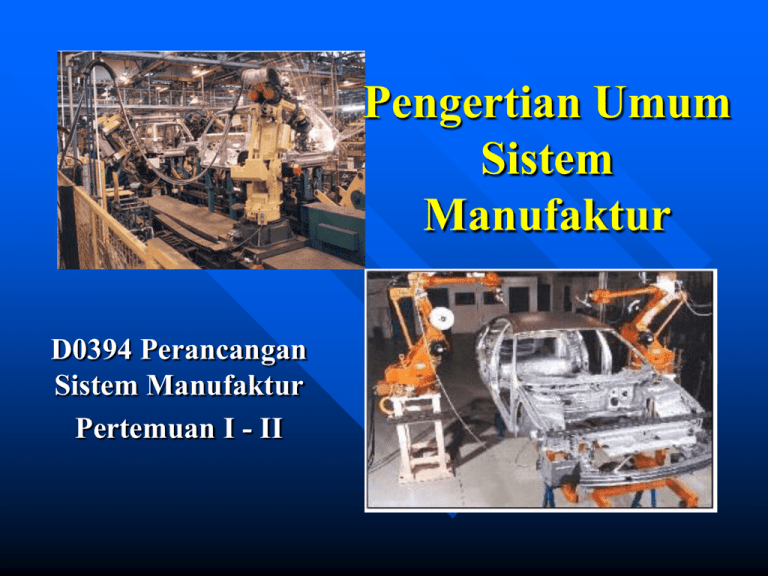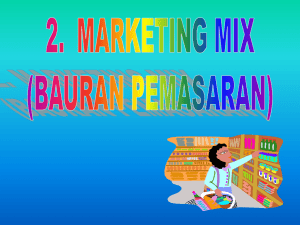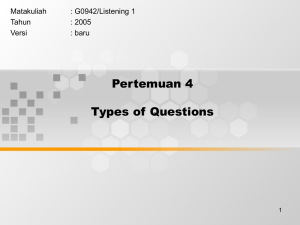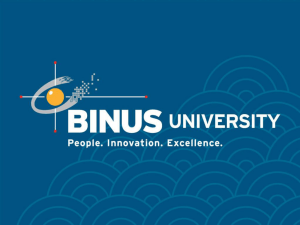Pengertian Umum Sistem Manufaktur D0394 Perancangan
advertisement

Pengertian Umum Sistem Manufaktur D0394 Perancangan Sistem Manufaktur Pertemuan I - II Definisi Manufaktur Manufacturing – Suatu kumpulan operasi dan aktifitas yang berkorelasi untuk menghasilkan produk, seperti perancangan produk, pemilihan bahan baku, perencanaan, pemrosesan, inspeksi, dan manajemen. Manufacturing process – Aktifitas manufaktur merubah bentuk suatu produk dengan mesin-mesin seperti, milling, drilling dll. Assembly – Kumpulan dari semua proses dengan mana bermacam komponen dan sub perakitan dibentuk bersamaan untuk membentuk rancangan rakitan atau produk secara geometris secara lengkap. Manufacturing System – Suatu pengorganisasian beberapa proses manufaktur dan perakitan yang saling berinteraksi. Tujuannya adalah untuk menjembatani dengan diluar fungsi produksi berkenaan dengan mengoptimasikan produktifitas kinerja sistem. Manufacturing – Historical Perspective English system (1800s) – Memperkenalkan mesin-mesin yang digunakan secara umum yang dapat digunakan untuk produk yang bervariasi. American system (1850s) – Menekankan pada presisi dan kemampuan untuk saling bertukar proses. Berubah dari “best fit” fokus kepada “greatest clearance without loss of functionality”. Scientific management (1900s) – Prespecified worker motions - Moved the control totally into the hands of management. Process improvement (SPC) (1950s) – Identical procedures produce different results on same machine at different times. Emphasized outliers instead of mean performance. Manufacturing – Historical Perspective Numerical control (1970s) – Combining the versatility of general purpose machines with the precision and control of special-purpose machines. Computer integrated manufacturing (1980s) – Pervasive use of computers to design products, plan production, control operations, and perform various business-related functions. Agile Manufacturing / Mass Customization (1990s) – Creation of highly flexible organizational structures that allow systems to produce highly customized product Manufacturing System Machines Raw Material “Finished” Products Characterized by: – Number of machines – Number of part types – Part routes through the system – Processing times – Machine setups – Demand patterns – Raw material/component availability – Equipment layout/configuration – Operator availability Manufacturing System Machines Raw Material Interested in: – Lead time for products – Cost of processing Decisions include: – System configuration – Scheduling methods “Finished” Products Manufacturing System Configurations Job Shop – Process layout that groups functionally similar machines Flow Line – Product layout that groups machines based on a product’s flow Cellular Manufacturing System – Hybrid layout that groups similar parts and the corresponding processing machines – Flexible Manufacturing System is an automated application Project Shop – Product is fixed and people and equipment brought to it Continuous Process Manufacturing System Configurations T T T T M M M D D G G G Job Shop Configuration T T M M M G G D Flow Line Configurations Manufacturing System Configurations Cell 1 Cell 2 Cell 4 Cell 3 Cellular Configuration Product Volume vs. Product Variety High Continuous Flow Line / Transfer Line Cellular / Flexible Mfg. Sys. Volume Low Job Shop Low High Variety Manufacturing System Design Manufacturing System Design Resource Requirement Resource Lay Out Material Flow Buffer Capacity Manufacturing System Operation Operation Decomposition – Planning » Deciding what to do – Scheduling » Deciding when to do what you planned – Execution » Carrying out the planned tasks according to the schedule Hierarchical System Structure – Shop – Workstation – Equipment Principles of Manufacturing Systems Little’s Law – WIP = Production Rate Throughput Time (L= W) Matter is conserved Larger scope implies reduced reliability Objects decay Exponential growth in complexity – M components, N states ==> NM possible system states Principles of Manufacturing Systems Technology advances System components appear to behave randomly Limits of (Human) rationality Combining, simplifying, and eliminating save time, money, and energy Manufacturing Systems Overview Product Design Process Planning Production System Design Production Planning Operational Planning Shop Floor Control Execution Product Design Idea » Understanding and identifying customer needs » Initial Design » Feasibility study to determine initial functionality Prototype Market Research Idea Generation (Product Design) Feasibility Study (Performance Specification) Preleminary Design (Prototype) » Market potential, economic analysis, strategic assessment Design Refinement » Functional specifications Detailed Specifications » Detailed design considering functions, quality/reliability, manufacturing, etc. Final Design (Final Design Specification) Process Planning (Manufacturing Specication) Product Design (Cont.) Functional analysis – Customer specifications – Product reliability Design for X – Manufacture or Assembly Simplification, standardization, modularization – Testing – Repair – Robustness to variations Concurrent engineering – Consider how product will be manufactured (process and production planning) during design phase Reduce cost and time to market Product Design (Cont.) Computer-Aided Design – Use of computer graphics to assist in the creation, modification, and analysis of a design – Common uses » » » » Geometric modeling Automated drafting and documentation Engineering analysis Design analysis CAD/CAM – Generation of manufacturing instructions directly from CAD design data Product Life Cycle Product (Consumer) Perspective – – – – Inception Design Production Use Production System (Manufacturer) Perspective » Maintenance and repair – Disposal – Reuse, recycle, scrap Design Ramp-up Maturity Decline Sale Time Production System Life Cycle Lifecycle – – – – – – Inception Design Construction Startup Use Closure Relationship to product lifecycle – Typically production system lifecycle is longer than an individual product’s lifecycle – Production system will revert to earlier stages in its lifecycle when new products are introduced » Extent and cost depends on system flexibility


